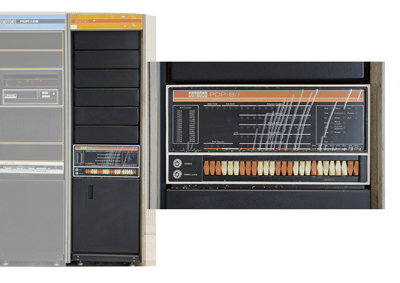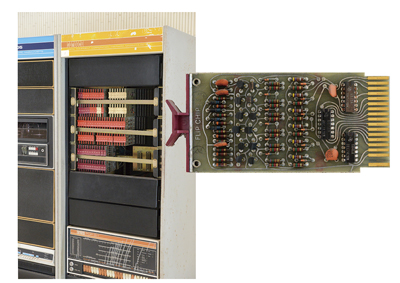

- Home >
- Artifacts of IP Heritage >
- 2014 >
- PDP-8/I
PDP-8/I


| Manufactured in | ca.1971 |
|---|---|
| Manufactured by | Digital Equipment Corporation |
| Owner | Kyoto Computer Gakuin |
| Location of historical materials | KCG Computer Museum, Kyoto Computer Gakuin, 10-5, Teranomae-cho, Nishikujyo, Minami-ku, Kyoto-city, Kyoto 601-8407 Japan |
| Visitor information | Open to the public (reservation required) |
| Contact | General Affairs Department, Kyoto Computer Gakuin Tel.+81-75-762-2030 https://www.kcg.ac.jp |
PDP-8 is a 12bit mini-computer released by Digital Equipment Corporation (DEC) in 1965. The great commercial success of this model established the category of mini-computers and made the manufacturer's name DEC as the leading company of the category. The internal structure of the machine consists of modular circuit cards named flip chips interconnected by the automated wire-wrapping which enabled a low cost production. PDP-8 was produced totally about 50 thousand units.
The time of the model's introduction people believed that computers were bigger the better in performance and having relatively lower cost. With this concept the scale of computers as well as the prices had been making a runaway growth. The computers were usually leased to the customer with the ownership retained by the manufacturer, which prevented the customers freely modifying the machines for their purposes. The PDP-8 was announced in such circumstances with an affordable 180 thousand dollars price tag. The university laboratories could buy and modify them referring to the open circuit diagrams from the manufacturer. This was the key factor of the machine's success. Various modification parts were available supplied by the third party companies. Another common usage of the machine was for the OEM makers to mount them in their special purpose machines as built-in controllers.
On the advent of microprocessors in later 1970s they rapidly replaced the mini-computers; eventually those machines disappeared.
